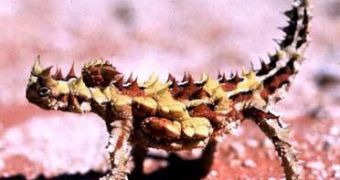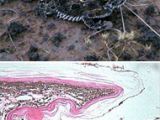While you waste hundreds of liters of water daily, as it flows continuously through the faucet (the question is for how long will we be able to afford this?), others struggle for any water droplet they can get. In some desert lizards, their entire body surface turned into an engineering miracle, a type of water sponge.
These reptiles have a network of tiny channels in the spaces between their scales that absorb water from the ground (or from rain droplets falling on them) and transport it to their mouth, drinking it.
A new research explains more on this bizarre adaptation to dry environments.
The Australian thorny devil (Moloch horridus) (a type of dragon or agamid lizard) rubs its belly onto the wet sand after a rainfall. In the 1920s, scientists found out that when put in a shallow bowl of water, the entire lizard body soon looked wet. "The initial thought was that they just took the water in directly through their skin. But unlike amphibian skin, which lets water through, reptile skin keeps precious water inside the body," said Wade Sherbrooke, a biologist at the American Museum of Natural History's Southwestern Research Station in Portal, Arizona.
Later researches 'detected' a transporting water system, along the "scale hinges" in between the lizard's scales.
Sherbrooke's team at James Cook University in Townsville, Australia, used light and electron microscopes to analyze the scale hinges. They found out that the hinges had tube-like channels about the width of 1-2 human hairs (up to 200 microns), a good size for forming capillary forces to draw in water. This network in thorny devils covers the lizard's whole body and heads the water to an area on the corner of the lizards' mouth.
A similar system has been detected on another desert lizard, the Texas horned lizard (Phrynosoma cornutum), related to iguanas, but not in seven related species that don't transport water.
"It's a really neat paper. This adds one of the big missing pieces and gets at the mechanism of how this cutaneous water transport works. One remaining puzzle is how the lizards keep the water flowing in the right direction. Both species make repetitive tongue movements that might somehow accomplish this--by moving water into the mouth drop by drop so that more liquid gets sucked up to take its place, for instance--but the details are a mystery," said Kurt Schwenk, an evolutionary biologist at the University of Connecticut in Storrs.

 14 DAY TRIAL //
14 DAY TRIAL // 
